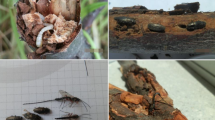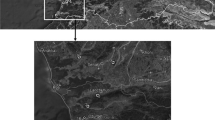Abstract
Population fluctuations of Pseudococcus cryptus Hempel (Hemiptera: Pseudococcidae) in citrus, role of the parasitoids, within total parasitism and levels of sooty-mold growth due to honeydew secretion of the pest on trees were revealed during the years of 2006–2009 in Samandağ district (Hatay). Additionally, populations of main predatory insects followed the prey populations during the growing season. In 2006, P. cryptus density was 3.41 egg clusters/leaf, 91.80 nymph + adult/leaf and the highest overall parasitism rate for was 41.63%. These figures were 2.23, 54.65 and 38.56%, in 2007; 3.33, 53.00 and 39.22%, in 2008; 4.18, 48.05 and 38.89%, in 2009, respectively. According to the samplings done in citrus orchards throughout the 3 years, P. cryptus populations started to rise in April, reaching the highest densities especially in June–July; and its population tended to decline starting from August due to natural enemies. The mean parasitization ratios as the proportion of the total parasitism were 68.15, 69.48, 70.55 and 71.06% for C. purpurea in 2006, 2007, 2008 and 2009, respectively. These figures were 14.58, 13.25, 12.94 and 12.58% for L. abnormis; 8.25, 7.35, 7.85 and 6.25% for A. pseudococci and 9.02, 9.92, 8.66 and 10.11% for P. muscarum. Levels of sooty-mold growth due to honeydew secretion by P. cryptus varied from 3.42/4 to 2.06/4 on citrus trees from 2006 to 2009, respectively.

Similar content being viewed by others
Change history
10 July 2019
In the original publication, Fig. 1 was incorrectly published with repeated values for the years 2008 and 2009.
References
Anonymous (2006) Policy for the importation of fresh mangoes (Mangifera indica) from Taiwan
Anonymous (2008) Zirai Mücadele Teknik Talimatları, vols 3, 4, 5. Tarım ve Köyişleri Bakanlığı, Tarımsal Araştırmalar Genel Müdürlüğü, Ankara
Anonymous (2017) Pseudococcus cryptus (Hempel) 1918 (Pseudococcidae: Pseudococcus). http://scalenet.info/catalogue/pseudococcus%20cryptus/. Accessed 21 Nov 2017
Anonymous (2018a) The World’s top citrus producing countries. https://www.worldatlas.com/articles/the-world-s-top-citrus-producing-countries.html. Accessed 11 Dec 2018
Anonymous (2018b) Pseudococcus cryptus Hempel. http://www.agri.huji.ac.il/mepests/pest/Pseudococcus_cryptus/. Accessed 11 Dec 2018
Avidov Z, Harpaz I (1969) Plant pests of Israel. Israel Universities Press, Jerusalem
Ben-Dov Y, Miller DR, Gibson GAP (2013) ScaleNet: a database of the scale insects of the world. http://www.sel.barc.usda.gov/scalenet/scalenet.htm. Accessed 10 May 2013
Blumberg D, Klein M, Mendel Z (1995) Response by encapsulation of four mealybug species (Homoptera; Pseudococcidae) to parasitization by Anagyrus pseudococci. Phytoparasitica 23(2):157–163
Blumberg D, Ben-Dov Y, Mendel Z (1999) The citriculus mealybug, Pseudococcus cryptus Hempel, and its natural enemies in Israel: history and present situation. Entomologica 33:233–242
Düzgüneş Z (1982) Türkiyede bulunan Pseudococcidae (Homoptera: Coccoidae) türleri üzerinde incelemeler. Ankara Üniversitesi, Ziraat Fakültesi Yayınları: 836, Ankara
Holat D, Kaydan MB, Muştu M (2014) Investigations on some biological characters of Pseudococcus cryptus (Hempel) (Hemiptera: Pseudococcidae) on four citrus species. Acta Zool Bulg Suppl 6:35–40
Horsburg RL, Asquith D (1968) Initial survey of arthropod predators of the European Red Mite in South Central Pennsylvania. J Econ Entomol 6:1752–1754
Kansu İA, Uygun N (1980) Doğu Akdeniz Bölgesi’nde turunçgil zararlıları ile tüm mücadele olanaklarının araştırılması. Çukurova Üniversitesi, Ziraat Fakültesi Yayınları: 141, Bil. Araş. ve İnc.: 33, Çukurova Üniversitesi, Ziraat Fakültesi, Ofset Baskı Ünit., Adana
Kaydan MB, Ülgentürk S, Erkılıç L (2013) Checklist of Turkish Coccoidea (Hemiptera: Sternorryncha) species. Türk Entomol Bült 3(4):157–182
Kim SC, Song J, Kim D (2008) Effect of temperature on the development and fecundity of the Cryptic Mealybug, Pseudococcus cryptus, in the laboratory. J Asia Pasific Entomol 11:149–153
McMurtry JA, Johnson EG, Scriven GT (1969) Experiments to determine effects of release of Stethorus picipes on the Avocado brown mite. J Econ Entomol 62:1216–1221
Soylu OZ, Ürel N (1977) Güney Anadolu Bölgesi turunçgillerinde zararlı böceklerin parazitoit ve predatörlerinin tespiti üzerine araştırmalar. Bitki Koruma Bülteni 17(2–4):77–112
Steiner H (1962) Methoden zur Untersuchung des populationdynamik in obstenlagen. Entomophaga 7(3):207–214
Ulu O (1984) Ege Bölgesi Turunçgillerinde zararlı Dialeurodes citri (Ashmead) (Hom.: Aleyrodidae)’nin tanınması, zararı, biyolojisi ve ekolojisi ile savaş olanakları üzerine araştırmalar. Bölge Zirai Mücadele Araştırma Enstitüsü, Bornova-İzmir (Ph. D. Thesis)
Yiğit A, Telli S (2013). Hatay ili turunçgillerinde zararlı Pseudococcus cryptus Hempel (Hemiptera: Pseudococcidae)’un yayılışı, konukçuları ve doğal düşmanları. Türk Entomol Derg 37(3): 359–373
Yiğit A, Canhilal R, Ekmekci U (2003) seasonal population fluactuations of Serangium parcesetosum (Coleoptera: Coccinellidae), a Predatory of Citrus Whitefly, Dialeurodes citri (Homoptera: Aleyrodidae) in Turkey’s Eastern Mediterranean Citrus Groves. Environ Entomol 32(5):1105–1114
Acknowledgements
We are thankful to Ahmet EminYıldırım for his contributions and reviewing the manuscript.
Funding
This study was not funded by any Institution or Establishment.
Author information
Authors and Affiliations
Corresponding author
Ethics declarations
Conflict of interest
The authors declare that they have no conflict of interest.
Additional information
Publisher's Note
Springer Nature remains neutral with regard to jurisdictional claims in published maps and institutional affiliations.
The original version of this article was revised: Figure 1 was incorrectly published with repeated values for the years 2008 and 2009 in the original publication. Now the figure is corrected in the original article.
Rights and permissions
About this article
Cite this article
Telli, S., Yiğit, A. Population fluctuations of the citriculus mealybug, Pseudococcus cryptus Hempel (Hemiptera: Pseudococcidae), in citrus orchards of Samandağ, Hatay, Turkey. J Plant Dis Prot 126, 421–426 (2019). https://doi.org/10.1007/s41348-019-00233-9
Received:
Accepted:
Published:
Issue Date:
DOI: https://doi.org/10.1007/s41348-019-00233-9




